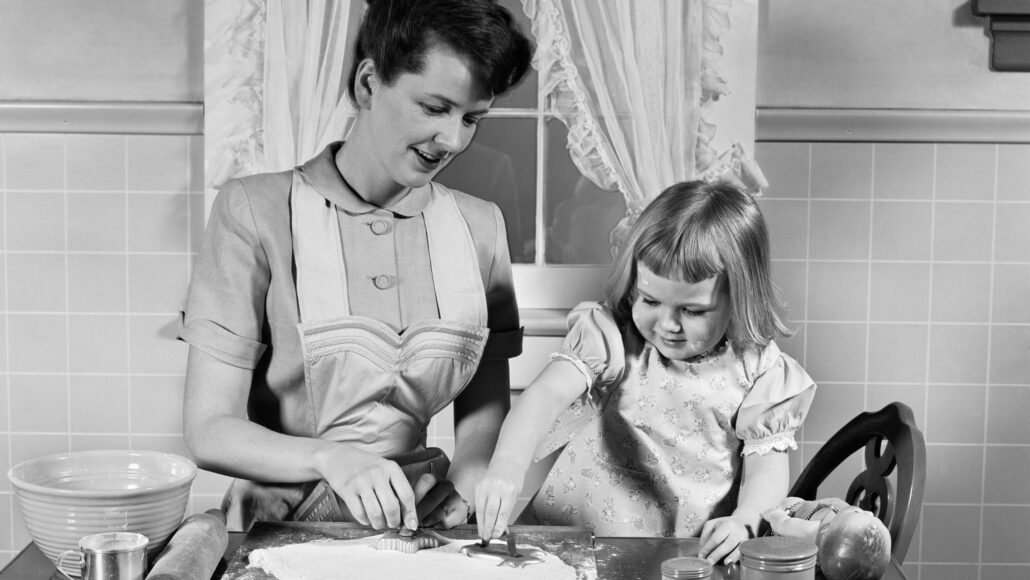
SAHM is an acronym for a stay-at-home mom. Typically, a SAHM is a woman who cares for the children while the other partner is working outside the home. Similar, more antiquated terms are a homemaker or housewife, although some people still embrace these monikers for this role.
The Role of a SAHM
SAHM often play many roles, meaning there’s not a single task that defines them. Typically, they handle many different jobs to keep the children engaged, fed, clean, active, and hitting developmental milestones, while also acting as the family’s housekeeper, organizer, social planner, treasurer, personal shopper, and chauffeur, among myriad other roles.
While they’re vital to their family, some may not understand or value this role and may debate a SAHM’s contributions to society as a whole. Others question why anyone would want to be an at-home parent. This negative dynamic can fuel what has been dubbed the “mommy wars,” where mom-shaming and judgment for how moms “should” act can lead to gossiping or blasting moms publicly on the Internet.
Potential Challenges
Unfortunately, our culture often has a cruel and unattainable understanding of what being a “good” SAHM entails—as well as heaping on the stigma that these women have it easy and are not equal contributors to society at large. Social media and even some scientific research push for unrealistic expectations (some of which are contradictory), including the following:
Kids Come First
SAHMs are expected to put their kids above all else, even ahead of their mental or physical health. Taking any time for yourself to exercise, eat a proper meal, hang out with friends, or even get a haircut can be seen as selfish to judgmental outsiders (and sometimes to SAHMs themselves) who believe the kids should be the sole focus.
Perfection is Expected
Moms get unhealthy messages from our society that only the best is good enough. There are some who believe that “good” SAHMs always feed their children homemade and healthy unprocessed foods, drastically limit screen time, keep a perpetually perfectly clean and tidy house, and spend their days engaged in creative, educational play with the kids.
While these goals certainly have their merits, it’s simply unrealistic to expect any parent to uphold them every minute of every day. What is fair is to expect SAHMs to do the best they can—and to assume that they are doing just that.
There’s Ample Time for Housework
Since SAHMs are thought to be at home all day long, it’s often also assumed that it should be easy to do all the laundry, cook all meals, dust, vacuum, and keep the house in tip-top shape every day. Watching children is time-consuming and a nonstop job. Many SAHMs are accustomed to starting a task only to be pulled away or picking up a mess only to have it return the minute a child gets up from a nap.
It’s Not Really Work
Many mothers note that they feel society expects them to quit their jobs once kids are in the picture, while simultaneously holding them to a standard that they are not contributing to the world if they do not work outside the home. This discredits the hard work stay-at-home moms do, sending the message that it’s not valued if an exchange of money is not involved.
Today’s Challenges
Society’s expectations rely on many outdated misconceptions about gender roles and long-held beliefs about motherhood, many of which have not caught up to today’s realities. Unfortunately, the role of the stay-at-home dad also suffers from criticism and isn’t safe from judgment either.
It’s Not the 1950s

If you have fond memories of the sound of the vacuum humming as your mom cleaned the whole house from top-to-bottom every day, washed, sorted, and ironed all the laundry, and made you and your siblings a hot meal to enjoy around the dining table once your dad came home, then you may also remember that your mom may not have actually spent many quality hours a day with you.
This doesn’t apply to everyone, of course, but there is a notable departure from this dynamic. In the past few decades, child-rearing best practices have changed dramatically. Research has now found that children learn best through interactive play, and so SAHMs are expected to provide environments for kids to engage in enriching play to develop their young brains. Plus, today’s social norms involve much more direct supervision.
From attending storytime with the toddler to driving the kids to soccer practice and watching them play, and setting up play dates between grocery runs, today’s SAHM may spend fewer hours a day in the actual home.
The “mom” role has also changed with time. A mother in the 1950s may have managed the inside of the home and the kids, while their spouse took care of things like yard work and finances. Today, many SAHMs now have these responsibilities and more, such as coordinating complicated after-school activity schedules and volunteering in their children’s classrooms.
The “Village” Has Disappeared
The saying goes that “it takes a village to raise a child.” Unfortunately, in today’s society, many moms (or stay-at-home dads) have very little help or support. However, more community support is often available if you know where to look for it, such as at local schools, community centers, or faith organizations.
Reaching out for connection and support can help address the loneliness or isolation some SAHMs experience as well as the overwhelmingness of the job.
In the past, it was common for families to be larger than they are today and for everyone in an extended family to live within a short distance of one another. This guaranteed “back up” could help moms get an hour or two a day to run errands (or get some respite) while their kids were being watched.
Impact of Smaller Families
Today, families tend move more and to be smaller than in years past, and it’s more common for relatives to live too far apart to help out regularly. Women are also having children later in life. In past generations, women had children at a younger age and tended to have more kids, which meant that their preteen could supervise younger siblings. That type of situation is less common today.4
Moms nowadays often spend most waking hours with their children, ensuring their supervision, enrichment, and nourishment all day long. Aside from the occasional mommy-and-me meet-ups and Facebook moms’ groups, some SAHMs do not have many daily interactions with other adults, particularly those without family nearby. This can make it difficult to connect with others that they, perhaps, could lean on.
Due to packed, varying schedules, and more parents working outside the home, many moms are unable to rely on neighbors the way they might have been able to in the past.5 On the other hand, many SAHMs find great community among other stay-at-home parents with similarly aged kids that they meet at playgrounds, in baby groups, or through other friends.
Opportunity Loss
Most families weigh the pros and cons of placing their new baby in childcare. Some decide that the mother will stay home from work and give up their salary (if they worked before getting pregnant) when it means that daycare costs, transportation, and after-hours care may add up to more than half of what they make at their job.
Choosing for the mom to stay at home means that the SAHM will have no outside income and will need to rely solely on their spouse for financial support. Many moms find this arrangement agreeable and cherish their time home with their kids. However, this time out of the workforce can lead to long-term career sacrifice, challenging new dynamics for some couples, and frustrating consequences.
It’s important to remember that when women leave the workforce to raise their children, more than just paychecks and promotions are given up. Maintaining valuable contacts, attending networking opportunities, and keeping skills current all become more difficult as well.
The amount of salary you are sacrificing and the value (in actual dollars) of the childcare and services you are providing is roughly the amount of money that your role as a SAHM brings to your family. This concept has led to the creation of online SAHM pay calculators to give you a better idea of the monetary value of the work you do as a SAHM.
Tips for SAHMs

While there is no right or wrong way to be a SAHM and being one will look and work differently for every family, there are some simple but essential tips that can help make the job less overwhelming and all-consuming—and more rewarding. Try the following suggestions:
- Aim to be present and savor the high points of each day—it doesn’t always feel like it but they really do grow up fast.
- Ask for help when needed (from your partner, family, friends, neighbors, your child’s daycare or school, doctors, or counselors).
- Cultivate community and a built-in support system by seeking out other stay-at-home parents with similarly aged children and lifestyles.
- Don’t compare yourself to other SAHMs, especially via social media, which is often highly curated and can easily leave you feeling inadequate.
- Don’t try to do it all—just because you’re a SAHM doesn’t mean you need (or should be able) to have daily elaborate meals, crafts, activities, and child enrichment and an expertly decorated, perpetually tidy home.
- Give your kids age-appropriate jobs, such as making beds, feeding the dog, and setting the table.
- Give yourself scheduled breaks, just like you would have at a paid job.
- Hold family meetings.
- Know that being a SAHM is a valuable and important job (even if it’s unpaid and under appreciated).
- Know that your best (or whatever you can muster that day) is enough—and more than anything else, your kids probably just want to snuggle with you on the couch to read a book or play together.
- Learn to say “No”— to your kids, obligations, and other requests for your time and attention. (Just because you’re “not working” does not mean you need to drive both ways on the carpool or chaperone the school field trip.)
- Practice self-care, such as yoga, meditation, a night out with friends, time to read a book or watch a movie, or even just a walk around the block.
- Set goals for yourself and your family.
History of SAHM
The term SAHM is often used in online mom groups, on parenting websites, and in everyday conversation to describe a mother’s role in the household who does not work outside the home—and is sometimes used in a dismissive or derogatory way. Traditionally, SAHM refers to a mom staying at home with the kids while their partner works to financially support the family.
Sometimes, society has a different understanding of the role of a SAHM as compared to what the experience is actually like for mothers who live it—and imparts undue pressure while also undermining the role. Many SAHMs feel undervalued and unappreciated for the work they do to raise their children, manage their families, and take care of their homes. Others feel more supported.
Is It Right for You?

While the SAHM life is not for everyone, and there are downsides, there are also many pluses. Many SAHMs say the biggest one is just always being there on a day-to-day basis with their kids. (Incidentally, this is also often seen as a drawback.) Other benefits include entrusting how your kids are raised, in terms of education, values, religion, and other beliefs, to yourself rather than an outside entity.
Ultimately, you will need to make the decision of whether or not to become a SAHM for yourself. However, it is only really feasible for people with the necessary financial resources and/or a partner whose salary can fully support the family.
Talk openly with your partner about the role you hope to take on if you become a SAHM. Do your research in terms of the opportunity cost of leaving your current paid work (if you have a job) and consider how much support you will have—financially and practically. Consider if you have other SAHM friends or family nearby to offer greater community and assistance while you’re at home.
If you think you’ll want to return to an outside job eventually, consider ways to keep some connection to your profession by signing up for networking platforms, working part-time or on a contract basis, or learning new skills, such as coding or a new language. Transitioning back into work after several years at home can be daunting, particularly if you haven’t kept those connections or your skills sharp.
A Final Word…
When it comes down to it, only you know what is right for your child and your family. As you decide whether or not to become a SAHM, don’t let societal stereotypes, judgments, or negativity pressure you one way or the other—or limit your vision for your family structure or what staying home with your kids could be.
If you choose to stay at home, trust that you can make the role your own, encompassing the guidelines, priorities, and values that fit your family. Also, know that you can always decide to go back to work when/if you decide the time is right.

0 Comments